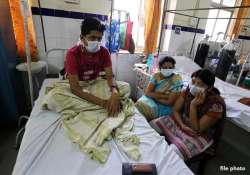Mutations make India's killer swine flu more dangerous: US study
Washington: The swine flu strain that has killed more than 1,200 people in India since December has acquired mutations that make it more dangerous than previously circulating strains of H1N1 influenza, a new MIT study

Washington: The swine flu strain that has killed more than 1,200 people in India since December has acquired mutations that make it more dangerous than previously circulating strains of H1N1 influenza, a new MIT study suggests.
The study by two Indian-American researchers contradicts previous reports from Indian health officials that the strain has not changed from the version of H1N1 that emerged in 2009 and has been circulating around the world ever since.
The finding of the research led by India-born Ram Sasisekharan, the Alfred H Caspary Professor of Biological Engineering at the Cambridge-based Massachusetts Institute of Technology, appear in the March 11 issue of Cell Host and Microbe.
With very little scientific data available about the new strain, the MIT researchers stress the need for better surveillance to track the outbreak and to help scientists to determine how to respond to this influenza variant.
"We're really caught between a rock and a hard place, with little information and a lot of misinformation," said Sasisekharan, the paper's senior author.
"When you do real-time surveillance, get organized, and deposit these sequences, then you can come up with a better strategy to respond to the virus."
In the past two years, genetic sequence information of the flu-virus protein hemagglutinin from only two influenza strains from India has been deposited into publicly available influenza databases.
This makes it difficult to determine exactly which strain is causing the new outbreak, and how it differs from previous strains.
However, those two strains yielded enough information to warrant concern, said Sasisekharan, who is also a member of MIT's Koch Institute for Integrative Cancer Research.
He and Kannan Tharakaraman, a research scientist in MIT's Department of Biological Engineering, compared the genetic sequences of those two strains to the strain of H1N1 that emerged in 2009 and killed more than 18,000 people worldwide between 2009 and 2012.
The researchers found that the recent Indian strains carry new mutations in the hemagglutinin protein that are known to make the virus more virulent.
Sasisekharan pointed out that more surveillance is needed to determine whether these mutations are present in the strain that is causing the current outbreak, which is most prevalent in the Indian states of Gujarat and Rajasthan and has infected more than 20,000 people so far.
Learning more about the new strains could help public health officials to determine which drugs might be effective and to design new vaccines for the next flu season, which will likely include strains that are now circulating.
"The goal is to get a clearer picture of the strains that are circulating and therefore anticipate the right kind of a vaccine strategy for 2016," Sasisekharan said.